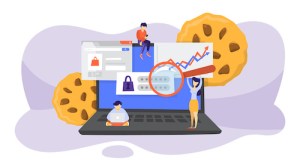With Google due to withdraw support for third-party cookies in early 2023 after Apple and Firefox set the precedent in 2020, marketers need to start preparing themselves for a cookieless future.
With 80% of marketers still using third-party cookies and only 9% ready for a world without them, organisations need to take action now. Below, I explain how organisations can use first-party data to support their personalised marketing efforts instead.
Balancing consumer privacy with targeted, relevant, and personalised marketing
In today’s information-rich world, consumers are bombarded with content. To make an impression, marketers and advertisers need to ensure their communications are highly targeted, personalised, and relevant. This is no longer a choice. We found that 73% of customers expect companies to understand their needs and expectations. So it’s vital to have a competitive advantage that you can demonstrate.
Customers are also increasingly worried about their privacy, however. In fact, 72% of consumers say they would stop buying from a company or using a service due to privacy concerns. This should also be an important consideration.
There are growing concerns around the use of consumer data and regulations such as GDPR. So it’s not surprising that Google is following its competitors and withdrawing support for third-party cookies. But how can organisations still correctly target consumers with meaningful content if they don’t have third-party cookie data at their fingertips?
Making an impression without third-party cookies
One option, which Google is working on, is FLOCs (Federated Learning of Cohorts). FLOCs enable targeted marketing by grouping customers according to their interests while protecting privacy by anonymising accounts.
With Google Chrome itself (and no longer the cookies) responsible for tracking browsing activity, it will still be able to create detailed profiles based on the various cohorts the user belongs. The level of personal information that the browser will be able to collect has raised some concerns for some privacy advocates.
Getting more from your first-party data is probably the best viable alternative to third-party cookies right now. For context, third-party cookies are used by advertisers and social media companies to track a customer’s online behaviour from site to site without them always being aware of it. Alternatively, first-party data – and zero-party data – is information that they’ve provided voluntarily. It might include their contact details, contact preferences, or personal likes and dislikes.
But to base their marketing and advertising strategies entirely on first-party data, organisations will need to ramp up their efforts. Here are three ways you can achieve more with first-party data:
Tip 1: Create a connection with your customers to gather richer information
Firstly, to replace the level of detail provided by third-party cookies, marketers need to boost the quantity and quality of the data they gather, while of course ensuring you have permission to use it as per GDPR requirements.
With 58% of customers comfortable with their personal information being used transparently and beneficially, there are several ways marketers can go about collecting consumer data. For example, you can use gamification, or launch contests, or create a community around your brand. You just need to be clear about how that data will be used.
However marketers choose to connect to their customers, it helps to stand out from the competition. One way to achieve this is to focus on ESG (environment, social, and governance) values. With 80% of customers more loyal to companies with good ethics, and 68% saying they won’t buy from companies with poor ethics, it’s important to invest in ESG activities for everyone’s benefit.
Tip 2: Connect, centralise, and democratise customer data to create a fuller picture
Once you’ve collected your customer data, you can increase the value of that data by connecting it together. From browsing and purchasing behaviour to service, sales, and marketing interactions – digital and otherwise – consolidating and centralising data will help you create a complete picture of your customer.
Then, you need to provide every member of customer-facing teams with the ability to access and update that data. By capturing every engagement and creating a single source of truth about each customer, you can deliver personalised communications at every stage of the customer journey.
Tip 3: Use customer identifiers and partner up instead of third-party cookies
Even without third-party cookies, you can still gain information about your customers’ behaviour outside of direct interactions with the company via customer identifiers. If marketers gain consent to use and share identifiers such as the customer’s email address, you can exchange it with partners, suppliers, and other brands to share customer information that fills in the gaps.
For example, a hotel reservation site can buddy up with an airline to better understand a customer’s plans. Or a fashion retailer can work with influencers to identify and target their audience. By bringing together multiple worlds within the customer’s sphere, companies can deliver a more contextualised and relevant experience for customers.
Final thoughts about third-party cookies and how to optimise your first-party data
In conclusion, a future without third-party cookies is far from bleak for marketers and advertisers. It’s actually a great opportunity to innovate and engage more with your customers. By improving the way you collect and manage first-party data now, you’ll be able to build stronger customer relationships, boost loyalty, and protect their privacy in the cookieless future.
To find out more about how Salesforce can help you optimise your first-party customer data, check out The Future of Data and Privacy in a Cookieless Future.
We’d like to give thanks to Thomas Boersma for his technical guidance and advice throughout this blog.
























